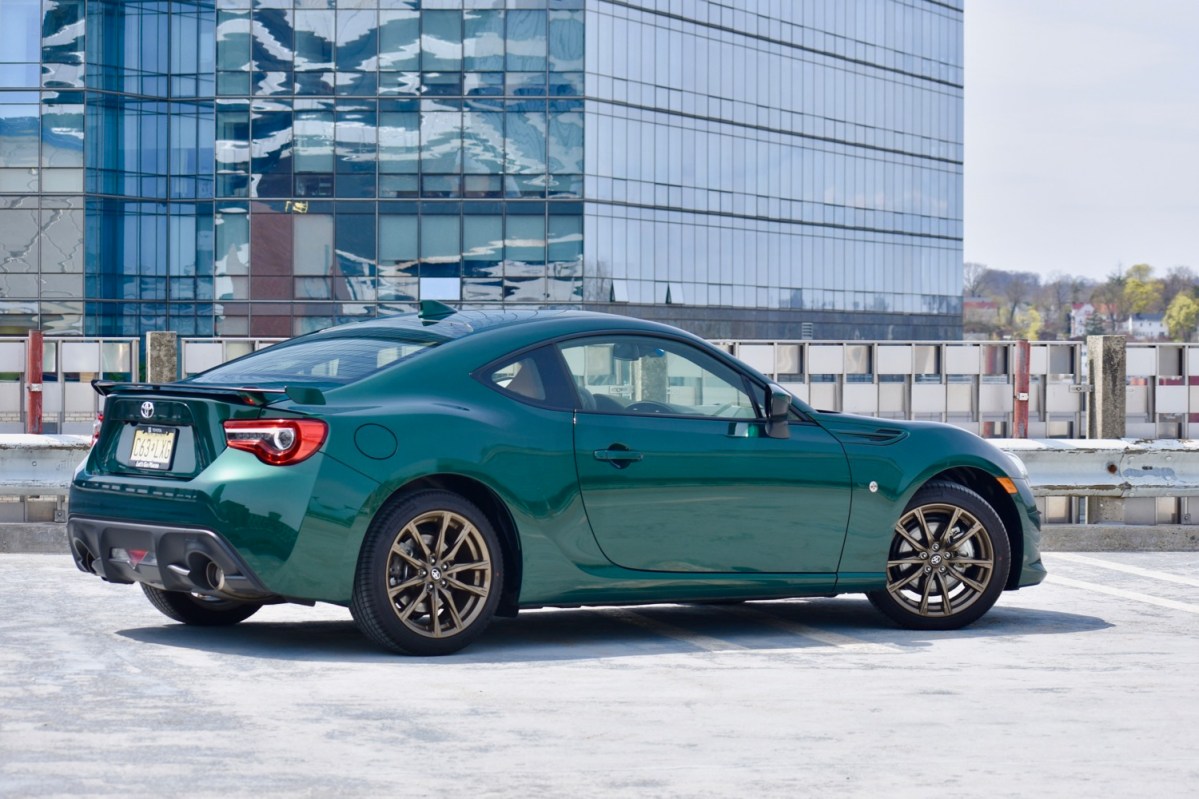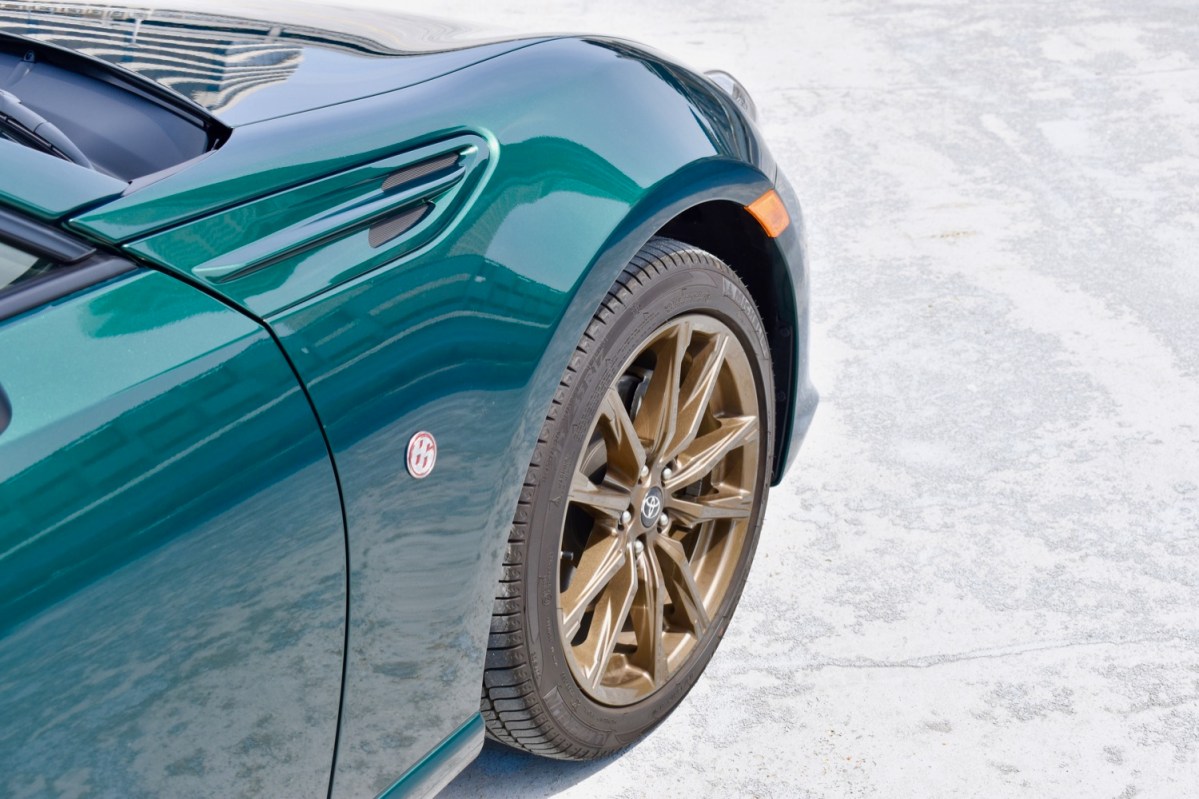- More powerful than the competition
- Nimble handling
- Comfortable cockpit
- Decently practical
- Lack of driver-assist tech
- Unpleasant exhaust note
The term “sports car” has become synonymous with “expensive.” What was once a source of cheap thrills in the 1940s and 1950s is now a status symbol. A Porsche 911 can crest six figures with options, and a Chevrolet Corvette is considered a bargain at nearly $60,000.
It doesn’t have to be this way.
Affordable sports cars still exist, if you know where to look. On paper, the 2020 Toyota 86 (pronounced “eight-six”) has everything you need for driving fun: An agile chassis, eager engine, available manual transmission, and rear-wheel drive. The little Toyota (and its Subaru BRZ sibling) provides some much-needed competition to the Mazda MX-5 Miata, which has dominated this space for over two decades.
Is the 86 as tasty as its ingredients suggest? To find out, we grabbed the leather-swathed key fob to a 2020 Toyota 86 Hakone Edition. Named after a famous Japanese road, it’s distinguished by green paint, bronze wheels, and tan seats. The Hakone Edition is priced at $30,825, compared to $28,015 for the base 86.
Design and interior
The Toyota 86 is a car of many names. It was co-developed with Subaru, which, as noted, sells its own version called the BRZ. Toyota’s version launched in the United States for the 2013 model year as the Scion FR-S, under the Japanese automaker’s now-defunct youth brand. When Scion was axed, the FR-S became the 86. The car hasn’t changed much over the years, though. The new-for-2020 Hakone Edition gets cosmetic changes only.

The name “86” is a reference to the 1986 AE86-model Toyota Corolla, but the two cars are very different. The AE86 was a tuner-friendly version of Toyota’s ubiquitous compact car, later made famous in the manga and anime “Initial D.” The 86, on the other hand, is a pure sports car. The two Toyotas do share one important thing, though: rear-wheel drive, which bestows superior handling. The 86 also uses a Subaru boxer engine, which helps lower the car’s center of gravity, further improving cornering ability.
Outward visibility is excellent, so you can place the car easily on the road and don’t have to grit your teeth while parallel parking.
In size and price, the 86 most closely matches the Mazda MX-5 Miata and its sibling, the Fiat 124 Spider. While the Mazda and Fiat are two-seat convertibles, however, the Toyota is a fixed-roof coupe with two tiny back seats. Those seats aren’t really suitable for humans, but they do add a useful amount of cargo space.
Toyota does not reveal trunk space for the 86, but Subaru quotes 6.9 cubic feet for the identical BRZ — more if you fold the rear seats down. That’s not much, but it’s more than you get in a Miata or 124 Spider. The Mazda and Fiat offer fractionally more headroom and a couple of inches of additional legroom, but unless you are as compact as they are, all of these cars will be a tight fit.

The 86 interior itself is plain but functional. The seats have thick bolsters, but are still comfortable enough for everyday use. The steering wheel is the perfect diameter and thickness, and the upright dashboard makes the cockpit feel a bit more spacious. Outward visibility is excellent, so you can place the car easily on the road and don’t have to grit your teeth while parallel parking. Materials aren’t fancy, but that is to be expected at this price.
Tech, infotainment, and driver assist
The simplicity of the 86 recalls classic sports cars, but so does its lack of tech. The car comes standard with a 7.0-inch touchscreen with Apple CarPlay and Android Auto — but that’s about it. The center console has just enough room for a smartphone, but plugging it in requires snaking a USB cable around the shifter.

Even the federally mandated rear view camera gets a low-tech execution. Images are shown on a tiny section of the rear view mirror, not on the main screen, or across the entire length of the mirror, as some automakers have done.
You get a bit more with the Toyota’s Subaru BRZ sibling. To justify a slightly higher purchase price, Subaru offers built-in navigation and a few more audio options, including Pandora and SiriusXM.
This is a car you can have fun in without risking jail time.
The 86 also doesn’t get the Toyota Safety Sense 2.0 bundle of driver aids that is standard equipment on most of the automaker’s other models. That means buyers miss out on features like adaptive cruise control and autonomous emergency braking.
The Mazda MX-5 Miata isn’t available with adaptive cruise control either, but autonomous emergency braking, blind spot monitoring, and traffic sign recognition are available. The Fiat 124 Spider gets blind spot monitoring and rear cross traffic alert as part of an optional package, but none of the other driver aids from its Mazda sibling.
Driving experience
The 86 wasn’t designed to be a tech leader. It was designed to offer the best possible driving experience for the price, and it does deliver.
Like a well-crafted cheeseburger, Toyota (and partner Subaru) didn’t try to make the 86 fancy — they focused on making a handful of basic ingredients as good as possible. The 86 is powered by a 2.0-liter four-cylinder engine sourced from Subaru that uses Toyota’s D-4S fuel-injection system, which toggles between direct injection and port injection to maximize efficiency. The engine has Subaru’s signature boxer configuration, which allows it to sit lower in the chassis. That lowers the car’s overall center of gravity, improving handling.
The boxer-four produces 205 horsepower and 156 pound-feet of torque in cars with the six-speed manual transmission, and 200 hp and 151 lb.-ft. with the six-speed automatic. That’s more than you get in the Mazda MX-5 Miata or Fiat 124 Spider, although the 86 can’t match the Fiat’s melodious exhaust note. The engine is also well -uited to sports-car duty, with an eager, rev-happy character.

The 86’s trim proportions, relatively low curb weight (Toyota quoted a 2,799-pound weight for our Hakone Edition test car), and rear-wheel drive make the most of that engine. Many performance cars try to mask poundage with an extra dollop of power, meaning most of the fun happens at extralegal speed. The 86’s agile and communicative chassis makes every corner into an event—no matter the speed. This is a car you can have fun in without risking jail time.
The 86 isn’t perfect — it’s easy to accidentally grab fifth gear when you want third, and a Miata is a tad sharper overall — but it’s pretty close. You also pay for that epic handling with ride quality that will make highway commuting painful. The suspension does nothing to lessen the impact of bumps, and the cabin is noisy. If you want more refinement, you’ll have to trade up to a Toyota Supra.
Gas mileage and safety
Another benefit of a light car with a small engine is good gas mileage. The 86 is rated at 24 mpg combined (21 mpg city, 28 mpg highway) with the manual transmission, and 27 mpg combined (24 mpg city, 32 mpg highway) with the automatic. Over a week of driving, we averaged 24.2 mpg (according to car’s trip computer), even with a fairly heavy throttle foot.
Real world results that match government ratings are always encouraging, but the 86 can’t match a manual-transmission Miata’s 29 mpg combined (26 mpg city, 34 mpg highway) or a manual 124 Spider’s 30 mpg (26 mpg city, 35 mpg highway). The Mazda has a 2.0-liter naturally aspirated four-cylinder engine like the Toyota, while the Fiat has a smaller, turbocharged 1.4-liter four-cylinder.
A benefit of a light car with a small engine is good gas mileage.
The 86 received the top “good” score in four of five Insurance Institute for Highway Safety (IIHS) crash tests, and was rated “acceptable” in the driver’s side small overlap front test. The Toyota has not received an overall rating from the National Highway Traffic Safety Administration (NHTSA).
Toyota offers a three-year, 36,000-mile basic warranty, and a five-year, 60,000-mile powertrain warranty. The automaker has a fairly good reputation for reliability. Subaru engines have a great reputation as well, although head gaskets are known to fail with high mileage. Replacements should be considered later in the car’s life.
How DT would configure this car
Hakone Edition models like our test car have unique style, and are likely a good bet for future collectibility. However, our ideal 86 would be a base model equipped with the optional TRD Handling Package, which isn’t available on the Hakone Edition.
TRD stands for Toyota Racing Development, the Japanese automaker’s performance division. Selecting this option means ditching the Hakone Edition’s snazzy green paint and 17-inch bronze wheels, but it adds Sachs dampers, Brembo brakes, and 18-inch wheels with stickier Michelin Pilot Sport 4S tires. The package costs $2,320, so added to the car’s $28,015 base price, it would still come out slightly cheaper than a Hakone Edition — but with even better handling.
The 86 also has great aftermarket support. If there is something you don’t like about this car, an aftermarket part probably exists to change it. We’d start with a new exhaust system. The stock system makes a lot of noise, but most of that noise isn’t good.
Our take
Few cars perform their intended function as well as the 2020 Toyota 86. A Mazda MX-5 Miata is a tad better to drive, but it’s not something the average driver will notice. The 86 also makes up for that with a pinch of practicality — and how often are you going to put the Mazda’s top down, really? The Fiat 124 Spider has a nice sound, retro styling, and a more comfortable ride, but it isn’t as sharp as the Toyota.
Toyota paid a price for its singular focus, however. For similar money, you can get cars that aren’t as pure as the 86, but have a greater breadth of talents. The Nissan 370Z boasts a 3.7-liter V6 with 332 horsepower, while sport compacts like the Honda Civic Si and Volkswagen Golf GTI offer everyday practicality. A Ford Mustang EcoBoost offers more space, power, and tech, but it also feels more like an ordinary car than a true sports car.
Should you get one?
Yes. The 86 defines cheap thrills.




